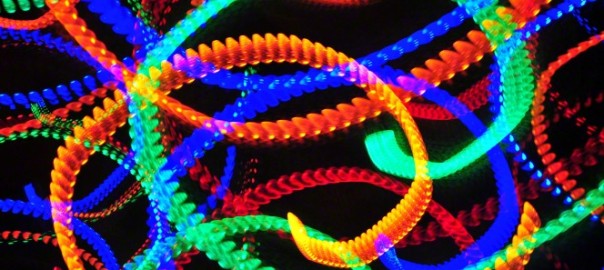I am not a physicist so please excuse my over simplifications of concepts that are undoubtedly very complex and nuanced. However, I have always loved physics and delving into how the world works. What spurs this post is that I’m reading a book by Brian Greene called The Fabric of the Cosmos, Space, Time, and the Texture of Reality, and I’ve had some thoughts come to me around how information might be conveyed at greater than light speed. I’m only in Chapter 4, so perhaps my question will yet be addressed, but I wanted to get my ideas down while they are still fresh.
In his book, Brian Greene talks about the quantum physics concept of particle entanglement, where two particles appears to affect each other instantaneously, despite being at a substantial distance from each other. He uses an analogy where Mulder and Scully are separated by some distance and each have a number of numbered alien cubes which are somehow connected. Opening the door on any cube yields either red or blue inside. So if Mulder opens cube 1 and receives a red result, when Scully opens the same numbered cube, she will receive the same result. This is meant to mimic the particle entanglement to measuring a single attribute of two such entangled particles.
He extends the analogy to explain how a different experiment was done to disprove the EPR theory that every particle has certain attributes even thought they cannot be measured due to the uncertainty principle. In this analogy, Mulder and Scully have cubes with 3 doors, each with red or blue inside. This represent that we can measure a particle’s spin in, say, 3 dimensions (3 doors), as either clockwise (red) or counter-clockwise(blue). If EPR was correct, randomly opening a door at each side would yield greater than 50% of the same result, (red or blue). That is because each cube has a minimum or 2 of the same color, and perhaps all 3. So the other cube is will match 2 out of 3 or better, over a large sample size. In the experiment, this turned out not to be the case, thus showing EPR to be wrong on that account.
However, if I understand the “uncertainty principle” correctly, once Mulder opens one door and it shows red, if he opens the other doors, they should be blank or have no color since only one attribute can be observed. In the case of spin, Brian explains that once you measure one dimension, say the front-to-back, all of the spin motion is conveyed onto that axis. Does that mean that whatever spin is zero for the other dimensions? That to me would be indicated by opening the second or third door on a cube and seeing nothing inside.
Now, given that, if I understand particle entanglement correctly, once one of the two particles has been measured along a specific axis, the other particle will also begin to only spin along that same axis. That would explain why the random sampling of opening doors was less than 50%, since now 2 out of 3 of the checks on the second box would yield neither red nor blue, but nothing (over large sample size).
That all makes sense to me so far. But here is the question: Since this occurs regardless of how far apart particles are, why could this not be used to convey information at speeds greater than the speed of light? In his book, Brian states that the test used to determine if something has traveled faster than the speed of light is whether information has been conveyed. He says that in this case, no information has been conveyed since the results are simple random samplings on each end and are only statistically proving the point. However, why do they have to be random?
To use the Mulder and Scully analogy, suppose Mulder tells Scully to always check the front door on the cube, while he alternates between checking the font door and some other door such that checking the front door indicates he wishes to send a “1” while checking something else indicates he wants to send a “0”. In that way, as Scully continuously checks the front door, she either gets an attribute reading (red or blue) which indicates a “1” or nothing which indicates a “0”. That is, she would see “nothing” due to the uncertainty principle when Mulder opened one of the other doors on his cube thus forcing her cube to only have a red/blue attribute on the door Mulder checked, not the front door which is the one Scully checked. In this way, a message can be encoded by reading the binary values from sequentially ordered pairs of entangled particles. And since it has been experimentally shown that these entanglements and corresponding state changes happen instantaneously, information would thus be traveling faster than the speed of light.
Obviously I’ve missed something that explains why this is not possible. I will continue to read Brian’s books to see what I learn further on this topic. But please chime in if you have the answer (and can explain it in terms I can follow!)

